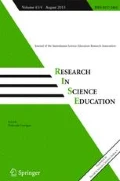Abstract
A study of primary school children's explanations of a range of phenomena concerning air pressure revealed considerable fluidity in their use of conceptions. A measure of consistency was developed and applied to children's written and oral explanations in a range of contexts. While the results showed a general trend with age toward more abstract, ‘generalizable’ conceptions, the notion of parsimony was found to be problematic on a number of levels. Children do not apply a single conception to a phenomenon, but rather operate with multiple conceptions in their explanations, complicating the whole notion of consistency. Moreover, as they develop and apply more advanced conceptions, children inevitably display temporary reductions in consistency. These findings suggest a rather more complex model of conceptual advance than implied in the literature on ‘conceptual change’.
Similar content being viewed by others
References
Brook, A. & Driver, R. (1988). Progression in science: the development of pupils' understanding of physical characteristics of air across the age range 5–16 years. University of Leeds: Children's Learning in Science Project.
Carey, S. (1985).Conceptual change in childhood. Cambridge, MA: MIT Press.
Carey, S. (1986). Cognitive science and science education,American Psychologist, 41(10), 1123–1130.
DiSessa, A. (1983). Phenomenology and the evolution of intuition. In D. Gentner & A.L. Stevens (Eds.)Mental models Hillsdale NJ: Lawrence Erlbaum and Associates, pp. 15–33.
DiSessa, A. (1988). Knowledge in pieces. In G. Forman & P.B. Pufall (Eds.)Constructivism in the computer age. Hillsdale NJ: Lawrence Erlbaum and Associates, pp. 49–70.
Driver, R. (1989). Students' conceptions and the learning of science.International Journal of Science Education, 11, 481–490.
Engel Clough, E. & Driver, R. (1986). A study of consistency in the use of students' conceptual frameworks across different task contexts.Science Education, 70(4), 473–496.
Finegold, M. & Gorsky, P. (1991). Students' concepts of force as applied to related physical systems: A search for consistency.International Journal of Science Education, 13, 97–113.
Fischbein, E., Stavy, R., & Ma-Naim, H. (1989). The psychological structure of naive impetus conceptions.International Journal of Science Education, 11, 71–81.
Gunstone, R., Champagne, A. & Klopfer, L. (1981). Instruction for understanding: A case study.Australian Science Teachers Journal, 27(3), 27–32.
Kuhn, T.S. (1970).The structure of scientific revolutions (2nd ed.) Chicago IL: University of Chicago Press.
Licht, P. & Thijs, G. (1990). Method to trace coherence and persistence of preconceptions.International Journal of Science Education, 12, 403–416.
Lijnse, P. (1990). Energy between the life-world of pupils and the world of physics.Science Education, 74(5), 571–583.
McCloskey, M. (1983). Intuitive physics.Scientific American, 248, 114–122.
Palmer, D. (1993). How consistently do students use their alternative conceptions?Research in Science Education, 23, 228–235.
Posner, G., Strike, K., Hewson, P. & Gertzog, W. (1982). Accommodation of a scientific conception: Toward a theory of conceptual change.Science Education, 66(2), 211–227.
Scott, P. (1987). The process of conceptual change in science: a case study of the development of a secondary pupil's ideas relating to matter.Proceedings of the Second International Seminar on Misconceptions and Educational Strategies in Science and Mathematics, Vol II, Ithaca, NY: Cornell University, pp. 404–419.
Tytler, R. (1992). Children's explanations of air pressure generated by small group activities.Research in Science Education, 22, 393–402.
Tytler, R. (1993). Developmental aspects of primary school children's construction of explanations in air pressure: the nature of conceptual change.Research in Science Education, 23, 308–316.
Watts, M. (1983). Some alternative views of energy.Physics Education, 18, 209–212.
Author information
Authors and Affiliations
Additional information
Specializations: children's science explanations, conceptual change, primary science teacher education, physics education.
Rights and permissions
About this article
Cite this article
Tytler, R. Consistency of children's use of science conceptions: Problems with the notion of “conceptual change”. Research in Science Education 24, 338–347 (1994). https://doi.org/10.1007/BF02356361
Issue Date:
DOI: https://doi.org/10.1007/BF02356361




